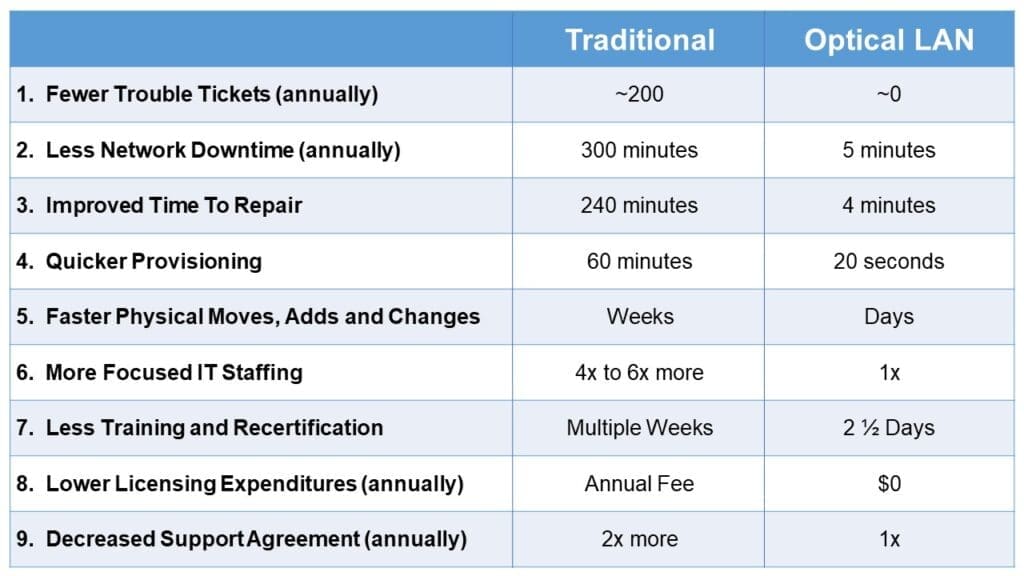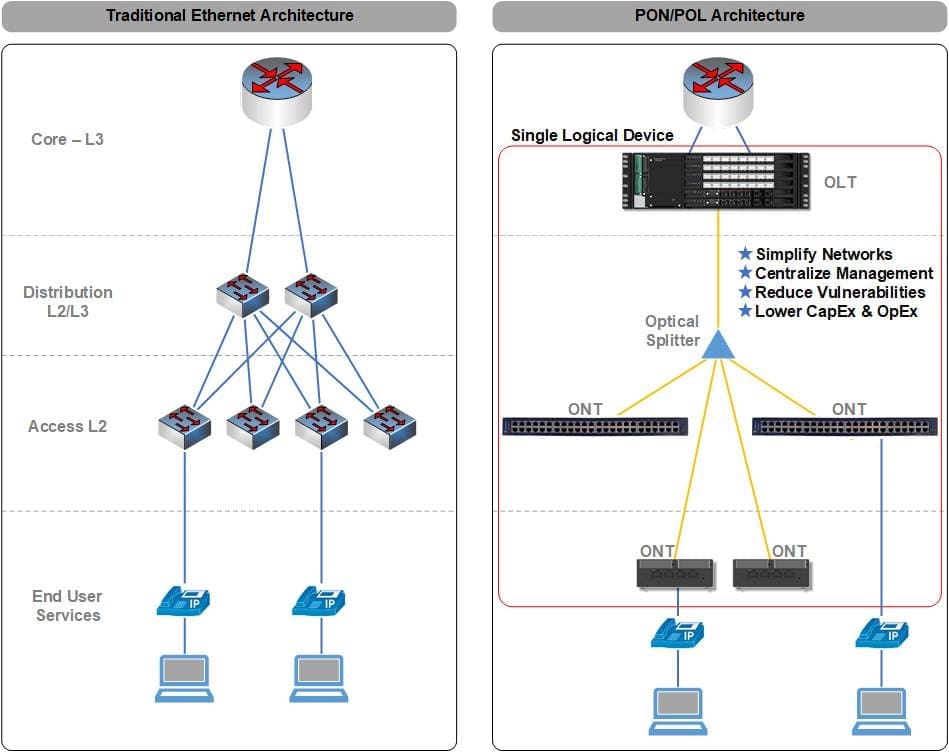Optical LAN architecture has proven to be more flexible in design, and lower in cost, all while balancing the escalating complexities of the modern network. Yet, often the Optical LAN tangible benefits associated with operational efficiencies get overlooked.
These year-over-year savings can pay annuities in the thousands and can quickly add up to millions of dollars for our customer. Our customers tell us that theses quantifiable benefits can be achieved as a result of Optical LAN’s superior performance in the following nine areas.

Now, let’s expand on these nine individual topics by providing some more details.
Fewer Trouble Tickets – Our customers have reported reduced trouble tickets resulting from unplanned network outages. In fact, several customers have reported zero trouble tickets spanning years of active service. The numbers showcased in this matrix, truly come from a large US government intelligence agency customer. This reduction is attributed to how an Optical LAN can be operated with less human touch which directly improves network reliability.
Less Network Downtime – Based on calculated average Mean Time Between Failure (MTBF), a traditional network design can expect 5 hours of network down time (99.9% uptime) and an Optical LAN can expect 5 minutes of down time (99.999% uptime). The cost to build a more resilient traditional network design with redundant switches, cards and ports configured in a more reliable meshed architecture is exorbitantly high.
Improved Time to Repair – Optical LAN is inherently easier to isolate trouble because of its passive architecture. That is, there are no moving parts between the OLT out to the ONTs, and the Tellabs Panorama PON Manager see all ports inside buildings and across extended campus as one big virtual switch. The matrix calculations are based on the replacing a rack-mounted 48-port workgroup switch, plus performing Security Technical Implementation Guide (STIG) on that switch, versus the simple plug-and-play process replacing an ONT.
Quicker Provisioning – Fundamentally Optical LAN is quicker to provision because of its underlying centralized intelligence and software defined management. With Tellabs Panorama PON Manager global profiles provisioning can be completed in 1-click or even zero touch. The bigger benefit of reduced provisioning is ensuring consistent procedures are implement without human error. Reduced human touch directly improves network reliability, security and operational efficiencies.
Faster Moves Adds and Changes – Modern networks need to be simple, flexible and scalable to support economical Moves, Adds and Changes (MACs). This can be exacerbated by large buildings and sprawling properties. With a traditional network architecture, adding connectivity ports may require moving or adding a cabinet, adding a new switch and/or running copper cabling all the way back to the main data room (MDF), telecom closet (IDF) or cabinet. This process is extremely time consuming, complex and expensive.
More Focused IT Staff – When discussing IT staff reductions, it is important to put this in context of addressing skillset gaps and talent shortage. The main objective of reducing the time and staff needed to operate a network, is that it unleashes your top-talent to focus on more critical tasks, like security or Wi-Fi performance. In the government sector, we commonly hear our customers experiencing a 4:1 to 6:1 repurposing of IT staff. In a recent case study, SK Food Group articulated how they were able to do the majority of their MACs with an IT Technicians (~$45 an hour) without needing to hire a more expensive Network Engineer (~$90-$130 an hour).
Less Training and Recertification – It’s well documented how traditional network manufacturers require multiple weeklong training every 2 to 3 years to maintain CCNA, CCNP or CCIE credentials. Even a prominent switch vendor CEO admitted that his company gains $15 in operational costs for every $1 in equipment cost. Tellabs Optical LAN operational, provisioning and maintenance (OPM) training class can be completed in 2 ½ days for significantly less cost.
Lower Licensing Costs – Major switch venders are complicating operations by constantly elevating network complexity with a hierarchy of software licensing expectations. They’ve also been steadily raising day-1 cost and year-over-year operational expenses of those licenses. Tellabs software is owned in perpetuity and does not require annual renewal.
Decreased Support Agreement Cost – OLAN can lower annual support costs compared to what traditional switch manufacturers charge. These types of year-over-year operational expense savings can be significant. For example, often OLAN customers can cut their annual support costs in half as they transitioned from a major switch vendor 24x7x365 annual support to Tellabs 24x7x365 annual support (including advanced equipment replacement).
Clearly there are significant savings to be gained from these nine areas. All of these factors amplify operational efficiencies for our customers. And best yet, when you multiply them year-over-year they can easily add up to thousands and millions of dollars over time.

If you would like to learn more about this topic you can visit our online Operational Efficiencies resources on our website. You can also connect with us on your favorite social media outlet, such as; Facebook, LinkedIn, Twitter, Instagram, and YouTube.

